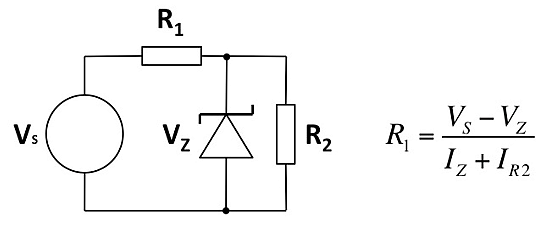In the circuit design process, according to different needs, we should choose different resistors to adjust the characteristics and performance requirements, such as your high voltage, high current and high power circuit, we need to use special resistors to meet the design Requirements, let's briefly explain how to use the adjustment resistor.
Linear Regulator
The following circuit is a zener diode to provide a constant regulated power supply for the load. The resistor is used to provide the minimum current to keep the diode in breakdown and provide load current. This kind of circuit is generally used for circuits with low power and stable supply voltage and load. If the current or voltage suddenly changes, it may exceed the working range of the Zener diode. In general, the resistance of this circuit is selected as long as it meets the rating. The power and the power of the load, as well as the power of the diode, are sufficient.
In a voltage unstable or unstable power supply circuit, the series circuit can use a transfer transistor to control the current stability and reduce the voltage value

The following circuits typically use ic or low-dropout regulators to regulate the load input. There are two resistors to divide the voltage. If the circuit has a fixed output, then the voltage divider is internal and for other components it can be externally placed 1 to 2. Resistance.

Switching power supply
Both the components and the loads on the series circuit consume power, and the energy efficiency ratio of the linear power supply is relatively low. If the load boost voltage increases, the efficiency of the entire circuit will be further reduced. In order to improve efficiency, we usually use the power supply topology, switching power supply (SMPS) uses unregulated input DC voltage and switches at high frequency (10kHz to 1MHz). The duty cycle determines the rectified and smoothed DC output voltage. SMPS output adjustment also uses a voltage divider, but to adjust the switching frequency and duty cycle. By avoiding the loss of linear regulator voltage drop, SMPS can achieve up to 95% efficiency. Due to the much smaller size of high-frequency transformers and filter/storage capacitors, SMPS may also be more compact than similar power linear AC-DC power supply designs.
The main disadvantage of SMPS is that it requires a minimum load and that the no-load condition may damage the power supply. To avoid this situation, designers often use a power resistor as a dummy load. If the main load is disconnected, this resistor can be used to absorb the minimum specific load current. Of course, the dummy load resistor also has power consumption, which affects the overall power supply efficiency, so this factor needs to be taken into consideration when selecting the resistor. Another way to circumvent this problem is to use a shunt resistor at the output when the load is open. For safety purposes, other resistors are also used in the SMPS design. Low resistance, high power resistors usually prevent overvoltage conditions. The current limiting design prevents short circuits.
This type of switching technology can also be used in DC-DC converter designs to adjust one value of a DC voltage to another value. The buck converter works very similar to the aforementioned SMPS design. Boost converters use charge pump technology to output higher voltages than the input. Both technologies use similar methods to regulate the output voltage and provide circuit protection.
Resistor
1. The main function of the discharge resistor is to discharge the capacitor in the circuit. During the use, the load is connected in parallel. When the power is off, the capacitor maintains the charging state, which may affect the user. Therefore, it needs to be discharged. We only need to consider two factors. The first is high resistance and the second can be quickly discharged.
2. The amount of surge current that may be caused by the surge capacitor limiting the storage capacitor. These resistors usually have low resistance and are in series with the AC power line. For higher power supplies, negative temperature coefficient resistors are often used. The resistance of the resistors is inversely proportional to the temperature. The disadvantage is that they must be hot during the operating hours. One possibility is to use a pulse resistor, which has very little power.
3. Balancing resistors are used to modulate the load current when multiple power supplies are used. In parallel circuit designs, multiple converters are used to provide low power consumption and cost savings. However, such circuits cannot simply connect the loads together. Using balanced resistors can well balance the output of each load.
4. The high voltage divider is used to provide feedback to the regulation circuit. These resistors usually have other secondary effects, such as monitoring the high voltage power supply in the defibrillator and charging the energy storage capacitor and turning off the power at the desired charge level.
Lead Acid Batteries,Lead Acid Batteries 12V 100Ah,Lead Acid Batteries Rechargeable,Solar Lead Acid Battery
Jiangsu Stark New Energy Co.,Ltd , https://www.stark-newenergy.com